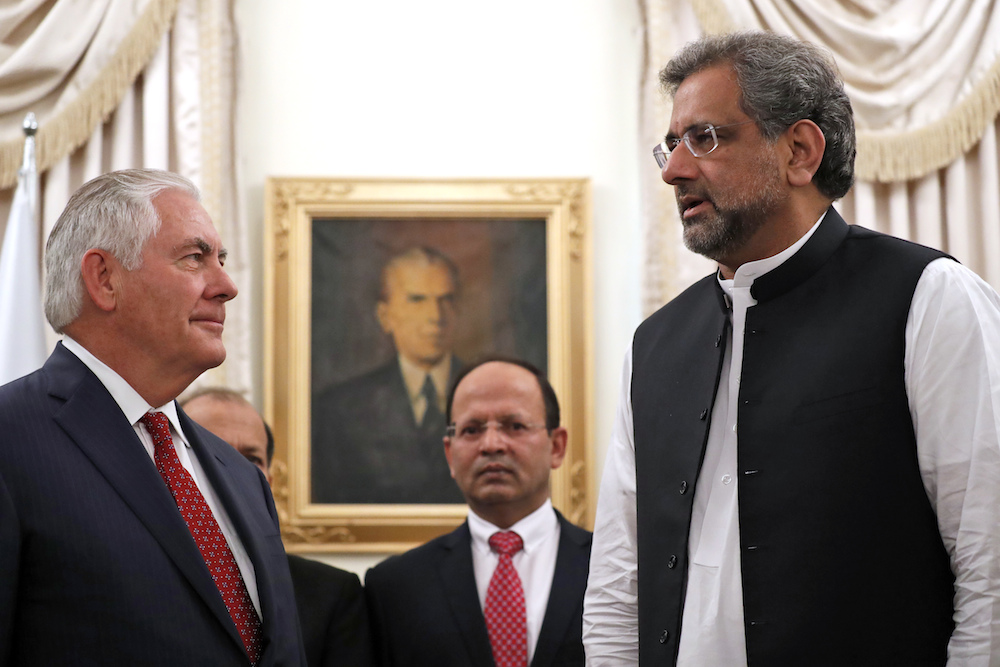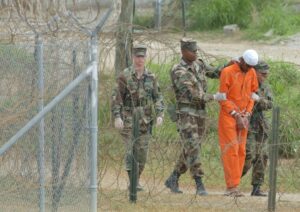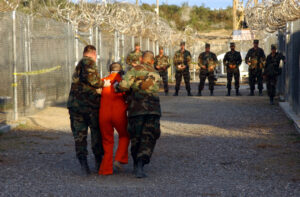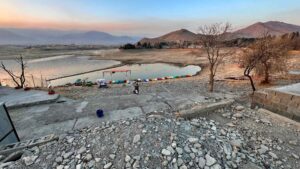New American Strategy in South Asia Targets Pakistan
President Trump seems to have abandoned the traditional, evenhanded U.S. stance toward the region’s two major powers, Pakistan and India. U.S. Secretary of State Rex Tillerson, left, is greeted by Pakistani Prime Minister Shahid Khan Abbasi in Islamabad, Pakistan, on Oct. 24. (Alex Brandon, Pool / AP)
U.S. Secretary of State Rex Tillerson, left, is greeted by Pakistani Prime Minister Shahid Khan Abbasi in Islamabad, Pakistan, on Oct. 24. (Alex Brandon, Pool / AP)
Secretary of State Rex Tillerson’s return to Washington after a hectic week in South Asia and the Middle East leaves us speculating on the purpose and result of his mission.
World attention was focused on his exercise in diplomacy for no other reason than that his trip was a follow-up on President Donald Trump’s announcement in August of a new South Asia strategy.
One would believe the move to be a simple case of the U.S. pushing for its goal of defeating the Taliban in Afghanistan and bringing peace and stability to the war-torn country. The new strategy spells a major shift in tone that seems to say, “America means business.” This can have a deep impact on regional politics. As is his style, Trump does not adopt a low-key or discreet stance. As a result, he alienates even potential allies.
The key features of his administration’s strategy are:
• U.S. troops will be ramped up in Afghanistan. “We will fight to win,” Trump said.
• American military will be given more autonomy in planning attacks on the Taliban.
• Washington will continue to seek a political settlement in the region.
• Pakistan will have to stop providing safe haven for terrorists. Trump was definitive when he said, “We have been paying Pakistan billions and billions of dollars, at the same time they are housing the very terrorists we are fighting. … That must change immediately.”
The president also called on India to “help us more with Afghanistan, especially in the area of economic assistance and development.” His stated rationale for this was the advantage India derives from its massive trade with the U.S.
America’s top diplomat was mercifully more subtle than his boss in his choice of words. But semantics failed to clear up the ambiguities in the American security plans in the region.
Because Pakistan is the main target of what many saw as American pressure, the reaction in this country was the most negative.
Top leaders in Islamabad of all political loyalties, who have not always been on the same page with the military on its Taliban policy, were equally vocal in expressing their displeasure with Tillerson. The chairman of the Senate (the upper house of Pakistan’s Parliament) likened Tillerson’s attitude to that of a “viceroy.” Foreign Minister Khwaja Asif mockingly pointed to the failure of the U.S. to curb the insurgency in Afghanistan, saying that the secretary of state could not even leave the U.S.-built Bagram Air Base during his visit. In fact, Tillerson’s visit to Kabul wasn’t announced in his itinerary and was shrouded in secrecy. This indicated the country’s low level of security despite 16 years of American military presence there. Pakistan’s foreign minister categorically refused to be a “scapegoat” for U.S. failures in Afghanistan.
What clearly emerged is that the U.S. is determined to destroy the safe havens of terrorists with or without Pakistan’s support. These havens include that of the Haqqani network, which is said to enjoy the Pakistan military’s backing. Tillerson gave a list of 75 names of so-called terrorists to his host, demanding that they be handed over or that information on their whereabouts be supplied to the U.S.
Yet in his post-visit briefing in Washington, Tillerson insisted that the U.S. had not made any demands on Pakistan. He did not use the word “demand”—a new vocabulary was created for the occasion. The word “expectation” substituted for “demand” and “good and open exchange” replaced “lecturing,” but both sides knew what was being hinted at. The undertone was clear. What remains a mystery to the public are the consequences of noncompliance, which Trump had indicated earlier would not be disclosed for strategic reasons.
It is not clear what is in store for Pakistan. The government has put on a brave face, and three days after Tillerson departed from Islamabad, the Foreign Office issued a statement asking the U.S. not to supply spy drones to India, as it would destabilize the region. America’s embrace of India is also disturbing for Pakistan.
It is not clear what role India would be encouraged to play in the region. Ostensibly it is to step up its economic activities. But it is understood that economics can lead to enhanced political clout, as well as military influence, in Afghanistan. This could exacerbate India’s already fraught relations with Pakistan. The constant worry is that rising tensions could trigger a nuclear war.
International politics in the region are more complex than they appear at first sight. Perhaps that explains why nothing was reported about the Pakistani army chief’s reaction to Tillerson’s visit, though he attended Tillerson’s meeting, along with the prime minister.
A number of existing splits make it a challenge for the center to hold in Pakistan. In addition to the basic civil-military divide, there is the alienation between the provinces, irreconcilable differences and infighting among political parties, the mushrooming and metamorphosis of militant groups pitted against one another and the polarization between the classes. Civilians in Pakistan are vulnerable and defenseless against the terrorists. All this is taking place in an economy that depends heavily on foreign aid.
One has no inkling of the strategy the U.S. plans to adopt. Will it be one for which a precedence exists? Simply step into Pakistan’s territory to execute its foreign policy piecemeal? This will evoke a reaction from the Pakistani public as well as the army.
The Abbottabad operation in 2011 convincingly demonstrated the U.S. capacity to act on Pakistani soil without cooperation from the host country. Osama bin Laden was seized and killed by SEALs transported by American helicopters, which flew over Pakistan’s air space without being challenged.
According to a New York Times report, a similar operation was recently considered to obtain the release of a Canadian-American couple and their children. The couple had been abducted by terrorists in 2012 and were being held in Pakistan. The Pakistani army pre-empted this blatant violation of Pakistani territory by taking steps to have the captives released just a week before Tillerson’s departure from Washington.
Is this to be the future shape of military operations? Will American boots be seen on Pakistani soil? The drones that attack from the air are not as effective or accurate and inflict high collateral damage.
Another cause for disquiet is the Trump administration’s obvious move to kill two birds with one stone. Trump wants to tame Pakistan and mobilize Saudi Arabia and a few other states in the region to form an anti-Iran coalition to neutralize Tehran’s growing influence. This would explain Tillerson’s need to act as a mediator between Riyadh and Doha—Qatar’s capital—and participate in the Saudi-Iraq Coordination Council while extending support to Saudi policy in Yemen. Trump recently pulled out of the Iran deal negotiated by his predecessor and is now polarizing the region.
Beyond his ambition to control the oil-rich Persian Gulf region lies Trump’s goal of countering Beijing’s loudly touted One Belt One Road Initiative, designed to make China a world power. Pakistan perceives the initiative as the only countervailing force to resist American economic hegemony.
These moves will create dilemmas for Pakistan, given its own ties with these countries—relationships that often require skillful navigation through stormy shoals.
The fact is that U.S. diplomacy today has gone far beyond the sinister aim disclosed by the Jimmy Carter-Zbigniew Brzezinski team of making Afghanistan the “Vietnam” of the Soviet Union in 1979. This strategy worked effectively and led to the dismantling of America’s archenemy at the time, the USSR. Islamabad pitched the support of its war machine behind the Afghan “freedom fighters,” who operated from sanctuaries in the border areas of Pakistan. This operation, known now as “Charlie Wilson’s war” or “Operation Cyclone,” received massive aid from the U.S.
The success of the Afghan “jihad,” which combined religious zeal with military prowess, was instructive for Pakistan. It learned how foreign policy could be conducted by using nonstate actors to infiltrate unfriendly neighbouring countries, ultimately destabilizing them to achieve military-cum-political goals. Throughout the 1990s, Pakistan adopted this strategy in Afghanistan, as well as in the Indian-held Kashmir Valley. This has continued in the post-9/11 period as well.
It needs to be remembered that there comes a time when Frankenstein’s monster loosens itself from the clutches of its creator. The Taliban, the freedom fighters of yesteryear, have turned on their benefactors, whether the erstwhile ones (the Americans) or the current ones (Pakistan’s intelligence agencies). The Pakistan army, like American forces, also has lost many soldiers at the hands of the terrorists.
At the root of these troubles is the failure of India and Pakistan to peacefully coexist 70 years after their birth. In the absence of coexistence, Pakistan always feels threatened and in need of strategic depth. In plain words, Pakistan needs a friendly Afghanistan on its border.
Trump’s new policy indicates another shift in U.S. South Asia strategy. He appears to have abandoned the even-handed stance Washington conventionally adopted vis-a-vis the two major powers of the region. This balance was missing during Tillerson’s visit. The secretary of state later disclosed that he had offered to help resolve the Kashmir issue, but he never explained why this offer—or its outcome—was not publicized during his visit.
Trump would do well to read up on history. I would recommend William Dalrymple’s “Return of a King,” which recounts the 19th-century Great Game, when Britain tried to effect a regime change in Kabul by going to war. Reviewer Tom Kyle summarizes a key section of Dalrymple’s work:
It was a sharp-eyed young officer on the walls of Jalalabad who saw him first, slowly riding a bedraggled and exhausted pony across the barren plain at the foot of the high mountain passes of Afghanistan.
When a rescue party reached him, they found a shadow of a man, his head sliced open, his tattered uniform heavily bloodstained.
He seemed more dead than alive but, when asked ‘Where is the Army?’, Assistant Surgeon William Brydon managed to reply: ‘I am the Army.’
It was January 13, 1842, and the 30-year-old Scot was all that remained of the British force that had invaded Afghanistan three years earlier.
The Army of the Indus, comprising 20,000 soldiers and twice that number of camp followers, had set off in the spring of 1839 to fight in the First Afghan War.
Trump should remember, too, that there were no Taliban or their Pakistani backers then.
Your support matters…Independent journalism is under threat and overshadowed by heavily funded mainstream media.
You can help level the playing field. Become a member.
Your tax-deductible contribution keeps us digging beneath the headlines to give you thought-provoking, investigative reporting and analysis that unearths what's really happening- without compromise.
Give today to support our courageous, independent journalists.






You need to be a supporter to comment.
There are currently no responses to this article.
Be the first to respond.